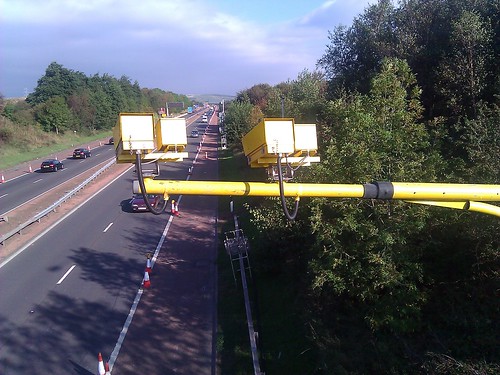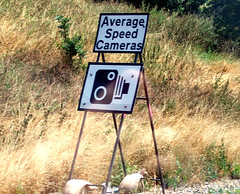

Over the last few years, the government implemented a network of 36 new digital cameras along the M25, a 117-mile stretch of road which is used by more than 500,000 vehicles per day. The cameras were supposed to catch speeders on the London orbital motorway, bot a series of technical and legal problems have plagued the system, and to date the new cameras have not caught any speeding drivers.
What Are Average Speed Cameras?
Average speed cameras are harder to spot than traditional speed cameras. They work by tracking your speed over a given distance, which means that they can’t be fooled by you slowing down just before the camera, and then speeding up after you pass it.
Average speed cameras usually work in pairs. Some of the cameras are just a couple of hundred meters apart, but in other areas they can be placed several miles apart. If your average speed over the distance between the two cameras is over the speed limit then you will be prosecuted. The system uses Automatic Number Plate Recognition to identify vehicles.
Use On The M25
The goal of the new network of digital average speed cameras, the first of which was installed back in 2009, was to clamp down on speeding and increase revenues. The M25 is an incredibly busy road and it is struggling to cope with rush hour traffic. There are some major road works being carried out on the M25 in an attempt to bring it up to date so that it can cope with the number of vehicles that use it every day.
There have been some temporary average speed cameras installed around the areas where the road works are being carried out and these cameras work well. The high-tech digital cameras, however, do not work at all. The Highways Agency has been forced to supplement those cameras with regular police patrols to enforce speed limits.
Cameras Awaiting Authorisation
One reason for the failure is that the Highways Agency has not yet received statutory  authority to use the cameras in Surry, Hertfordshire and Essex. The agency can use the previous generation of cameras in those areas, but the new digital ones require a separate authorization. Even in areas where the cameras may be used, there have been technical issues preventing the use of the cameras.
authority to use the cameras in Surry, Hertfordshire and Essex. The agency can use the previous generation of cameras in those areas, but the new digital ones require a separate authorization. Even in areas where the cameras may be used, there have been technical issues preventing the use of the cameras.
Safety campaigners have spoken out against the “incompetence” of the Highways Agency, asking why it has taken so long for the cameras to be implemented. There have been discussions about the issues with the cameras on many motoring boards for the past couple of years, with some drivers discussing whether or not the cameras work, and others discussing ways to get around the average speed system.
Protecting Road Users
Speed cameras are a hot topic among motorists, with some believing that they do act as a deterrent, and others suggesting that they make roads more dangerous by encouraging people to drive erratically in order to try to trick the cameras.
The M25 sees a lot of reckless drivers, especially on weekends. If the new cameras could be brought into operation and stop those drivers, then that would be a huge step forward.
Photo: Craig Murphy, Brett Jordan




